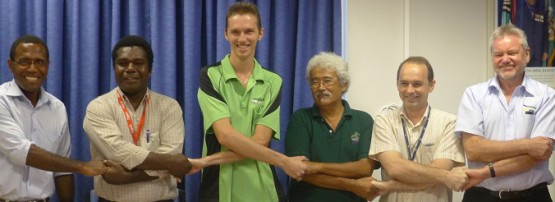
At the Pacific Industry Workshop at APNIC 38, Jethro Webston from Vanuatu’s Office of the Govt CIO gave an update on the Vanuatu Internet Exchange (VIX). It was a good insight into how an IXP can help fuel Internet development in the Pacific.
The VIX is housed in a government data center, offering members a Multi-lateral Peering Agreement (MLPA) to establish a single peering with the route server. The initiative dates to 2012, when five ISPs formed an MoU (Telsat, Digicel, Can’L, SPMI and Vanuatu Govt), and applied for the IX block and ASN from APNIC.
The service went live in 2013 with a switch and server, and by mid-February 2014 they went live with their first peering. APNIC assisted with equipment and advice and the relationship continues, ably assisted by Philip Smith.
A Google cache was deployed in August 2013, and an I-root server in November 2013. The last telecommunications provider, the incumbent, joined in May 2014. The entire Vanuatu community of six network operators are now connected. IPv6 peering is available and YouTube video is locally cached. APNIC’s IPv6 measurements from Labs measures Vanuatu at 0.78% IPv6 capable, 3rd in the region after Australia and New Zealand.
The initiative benefited hugely from the regulator participating. The choice of a neutral location – in the face of some operators initially not being willing to connect – was also an important experience. There are strong relationships between the availability of the local content cache (Google) and the impact on the submarine cable bandwidth. This is likely to be a shared experience for the Pacific Island economies.
With a population of 200,000, Vanuatu has six ISPs, so demonstrates a mix of competition and former monopoly telco market status. The creation of a peering point for neutral exchange and MLPA, combined with the inclusion of the regulator, speaks to the benefits of an island community in cooperating and competing to deliver services. Sixty percent or more of the APNIC measurements come from Vanuatu Telecom, suggesting it retains a significant market share but a broadband provider (TELSAT) and the Vanuatu Government also have significant market share. Digitel providing wireless may not be measured in our system.
At only 800km to New Caledonia, the opportunities for collaboration in caching and high bandwidth services may exist. Fiji is 1,200km away so represents a slightly longer hop, but also good for a data path to the US and Japan.
The views expressed by the authors of this blog are their own and do not necessarily reflect the views of APNIC. Please note a Code of Conduct applies to this blog.
